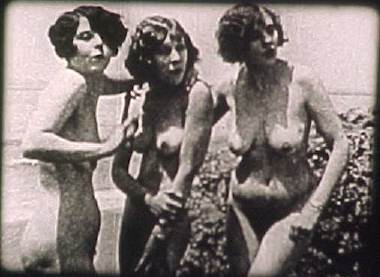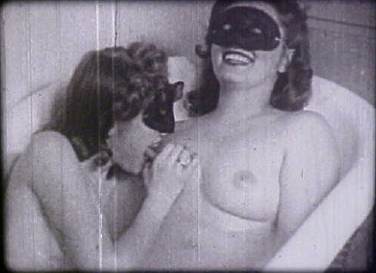Without even having seen it, you probably wouldn’t be surprised to learn the plot of the sexually explicit film “The Casting Couch.” In it, a young woman walks into a producer’s studio for an audition and is soon coerced into sex as quid pro quo for a part in an upcoming film. It’s a tired trope, one that’s become as routine in adult movies as the rumored Hollywood practice from which it derives its name. But there is something surprising about “The Casting Couch.” It’s a silent, black-and-white porno filmed circa 1924.
Advertisement
The movie is one of thousands of stag films, a species of hardcore movie shot from the dawn of cinema until it petered out in the Golden Age of Porn, which started in the late 60s and flourished through the 70s. Stags were silent black-and-white films of about five to ten minutes, which featured brief narrative scenes bracketing a near-random jumble of penetration, thrusting, “meat shots,” and, at times, snippets of oral and ejaculation. Which may seem odd. There’s a widespread and understandable belief that sexual openness moves in a linear fashion, says Albert Steg, a film collector familiar with stag movies. As a result, hardcore stag films are novelties of cognitive dissonance. They feel like they shouldn’t have been made in the 1920s.However, these films are more than oddities. They’re a potent window into elements of sexuality and social relations in the early 20th century largely absent from the rest of the historical record. They connect so much that seems utterly modern with the past, and make that history more human in complicated, visceral ways.Stag is often confused with early “nudie” films and features containing sexual content. But they are more than that, says media historian Joseph Slade. Stag films were illicit, produced anonymously and outside of the film studio system. While the earliest known stag film has been softly dated to 1915, no one knows when the genre really originated. It took off in the 20s with the emergence of some of the earliest mass-accessible cameras and projectors. Entrepreneurs, likely with the aid of organized crime, shot the films around the nation, then trafficked them to towns where masculine communal organizations like the Elks, Legionnaires, Rotarians, or college frats would host “stag parties,” chipping in to host screenings in which they’d all watch hardcore sex together. It was a solid business model—so solid producers saw no need to innovate for decades, ossifying a silent, chaotic, and colorless style.
Advertisement
In the 50s, 8mm film and smaller cameras meant for home movies allowed more localized production and screenings, and that community aspect of stag was largely lost. Producers moved away from stag conventions in the 60s. New adult stores created infrastructure for viewing booths showing continual loops of 8mm sexual scenes, and then color and sound started to take hold in porn. By 1968, stag films were completely dead, replaced by feature length porn with increasingly involved storylines and pornographic conventions, like cohesive sexual encounters as opposed to stag’s jumble of quasi-random sex clips shoved between opening and closing narratives.

A decade later, stag films had all but disappeared from popular consciousness. But historians maintained a keen interest in them. Some, like amateur historians Al Di Lauro and Gerald Rabkin argued (in their 1976 tome Dirty Movies: An Illustrated History of Stag Film, 1915–1970) that the films were records of our authentic, joyous, but largely hidden amateur sexual past. They are a vital chapter in the evolution of modern porn (many stag directors went on to work on Golden Age films) and a window into the history of sex work, the place of women within it, and sexual consumption.Yet academics have had a hard time digging into and unpacking stag films. There’s no grand catalog of all the stag films ever made, no record of who made them to track people down and ask about their work, no way to know for sure how the pieces of this genre puzzle fit together or even if researchers have them all.
Advertisement
There is only one well-known and substantial stag film archive, built at the height of the stag era by pioneering sexuality researcher Alfred Kinsey at the Indiana University Bloomington. From 1948 to 1956, Kinsey and his team bought up copies of stag when and where they could, taking down information about the men who sold the films to them. They also worked out deals with police departments around the nation to send them whatever copies they’d seized in raids. Archive administrator Shawn C. Wilson estimates they have 1,600 films today.Wilson claims the Kinsey archive is well tended to—that all of the films are in good shape, have gone through digitization, and are regularly used by visitors and scholars. He also notes that the collection is still growing as people send them new finds from, say, grandpa’s old storage closet. But Slade and other media historians who depend on this archive for their stag research, describe it as less than accessible, and say many of its films are decaying past the point of visibility. For its part, the University of Indiana appears to be both proud of Kinsey and a little uneasy about this collection, having only shown it publicly once in 2003 on the 50-year anniversary of Kinsey’s Sexual Behavior in the Human Female.Linda Williams, a porn media scholar at University of California, Berkeley, and author of the 1989 book Hard Core, also points out that “Kinsey did not seek for the films” in his collection “to be representative, either of pornography” or the sexual practices at the time. He was an indiscriminate collector, so it’s hard to look at his archive as a definitive and reliable record of stag film history or contents.
Advertisement
Elsewhere, Slade says that San Francisco’s Institute for the Advanced Study of Sexuality and New York’s Museum of Sex both have stag film archives. But they’re largely un-catalogued and hard to navigate. “None of the world’s half-dozen major sex museums have significant holdings,” he says. Other film preservation groups occasionally get a box or two of them, according to Steg. But “they are often left un-catalogued or minimally described, so they can’t be accessed.”“Most of the best archives, though none are as complete as Kinsey’s, are in private hands,” says Slade. Yet while private collectors may make more effort to find stags, that task is an incredibly difficult game of chance. Mike Vraney of Seattle-based exploitation film distributor Something Weird started collecting 16 and 8mm stag and early Golden Age films in the early 1990s and continued until just before his death in 2014, amassing a few hundred items, his wife Lisa Petrucci tells me. But he only got into it after finding his first haul in an abandoned storage unit, and kept building it by stumbling across random boxes while stalking eBay for new content.Nico Bruinsma of Los Angeles–based distributor Cult Epics likewise says most of his finds are chance encounters in thrift stores or when he happens upon them in other people’s collections. That’s how Steg, himself a collector, finds his stag as well.
"Nylon Man" (1940s). Stills via Albert Steg.
Private collectors who are also distributors try to make their collections available to the public (read: to monetize them). But they don’t present the stag clips as they are, and instead often edit them into loops, like Something Weird’s 14 two-hour volumes of Grandpa Buckey’s Naughty Stag Loops and Peeps. Occasionally these distributors mix them in with post-stag loops or clips from nudie features made parallel to stags in the early 20th century, making no efforts to differentiate, and thus further adding to the popular confusion about what constitutes a stag film. They also blend them with new music, mix them (as Slade put it) “with stupid commentary,” scramble them up, re-title them, and don’t give any of the key details on provenance or context. These tweaks help to hold a modern audience, make sales, and market the nostalgia and oddity factors that move these titles, but they’re of little use to those looking to know stags as they were or those interested in preserving them.
Advertisement

All of this makes the prospect of building a more comprehensive and accessible stag archive for popular engagement and hardcore research pretty damn daunting. Like many old and neglected films, at least half (in Slade’s estimation) of all stags that existed have probably been destroyed, whether in censorship raids of the era, by subsequent wear and tear, or neglect. Existing archives are largely opaque or jumbled, making them hard to piece together. And proactive collecting is hampered by the utter lack of clues or trails for collectors to follow, save monitoring eBay or hoping you stumble upon something here or there of interest or historic value.“I have little hope for preserving stag films,” says Williams. “No one seems willing to pay for preservation.The longer stag films stay hidden, scattered, or jumbled, the harder it is for us to access a rapidly fading part of our own social and sexual history, and to understand the bearings it has on modern sex, gender, and pornography.Our only hope is that this challenge and threat motivates scholars, collectors, and general smut history enthusiasts to pressure existing archives and private collectors to publicize their content, bridge gaps between one another, and push research and restoration. We can also hope that the allure of the hunt for truly ephemeral content will motivate collectors to push harder to find and publicize new bits and pieces of stag history. That is, after all, part of what it means to be a true collector, according to Steg.“It’s more fun to look for something that isn’t easy to find, and it provides a sense of purpose,” he said. “You’re preserving something from oblivion.”Sign up for our newsletter to get the best of VICE delivered to your inbox daily.Follow Mark Hay on Twitter.
